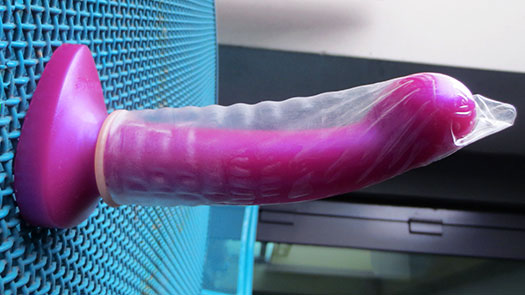Let’s delve into the science of lubricant safety!
References:
BadVibes.org
pH info from Sarah E. Mueller’s presentation (see slide 12)
Osmolality/irritation study
ID Glide/rectal damage study
Epiphora’s notes from Sarah E. Mueller’s presentation
Recommended Lubes:
Sliquid
Good Clean Love Almost Naked
Aloe Cadabra
Yes
Blossom Organics
Waterslide

Around 6 months ago I made a video going over the different types of sex lubricants and their uses. I talked a little bit about questionable ingredients in that video, but today I want to really get into the science-y side of lubricant safety, specifically the issues of osmolality and pH. There’s a lot to learn, but I’m going to try to keep it really simple and basically just introduce you to common causes of irritation and how to identify and avoid them.
Osmolality is sometimes referred to as the concentration of a solution. It’s the measure of dissolved particles per unit of water. The osmolality of a water-based or hybrid lubricant is super important because it can affect the homeostasis of your nether region’s mucous membranes. It’s a hydration issue, basically. If something has a lower osmolality (i.e. a higher concentration of water) than your body’s natural cells, then your cells are going to pull water from it. Too much water and the cells can actually rupture. And if something has a higher osmolality than the body, it’s going to pull water FROM your cells, dehydrating and potentially killing them.
A study published in 2008 in the American Sexually Transmitted Diseases Association’s official journal found that the osmolality of a lubricant is closely linked to its potential for mucous membrane irritation. Hypo-osmotic lubricants with a lower osmolality than the body caused negative mucous production in test subjects, while hyperosmotic lubricants caused irritation and tissue damage proportional to their level of osmolality, up to “severe” damage from the worst offender (Astroglide).
A 2006 study conducted by a research team led by Craig W. Hendrix, a clinical pharmacologist at Johns Hopkins, found that hyperosmotic lubricant ID Glide caused significant rectal tissue damage in humans and may actually increase susceptibility to HIV and other STIs.
For comparison purposes, the average osmolality of vaginal mucous is between 260-290 milliosmoles per kilogram (mOsm/kg), and human semen is between 260 and 380. The osmolality of popular commercially-available lubricants, on the other hand, is often over 2000, even surpassing 10000 mOsm/kg.
Iso-osmotic lubricants, which are similar to the body’s natural osmolality, have been found to be the safest, causing little to no change in the mucous membranes of test subjects.
Now, what does that mean for a consumer? Obviously most of us can’t test the osmolality of our lubes ourselves, so how do we know what’s safe to use?
Well the first step is to learn what ingredients are typically found in hyperosmotic lubricants. The two biggest ones are propylene glycol, a petrochemical, and glycerin, a sugar alcohol that is used as a humectant. Just seeing one of those two ingredients on a lube package is an immediate indication that the product is likely hyperosmotic, and it seems like most widely-available water-based lubes contain both. So that’s not great.
Brands that come closest to the ideal osmolality include Good Clean Love, Sliquid, and Aloe Cadabra. I’m sure there are others, but unfortunately many brands haven’t been tested or haven’t publicized their osmolality, so I don’t have numbers for them.
If you’ve ever taken a chemistry class, you’ve probably heard the term pH, which is the measure of acidity or basicity of a solution. Various areas of the body have different pHs, and the body regulates all this itself with a balance of natural bacteria, fungi, and body secretions. A balanced pH is important to avoid infection, but foreign substances can throw it off balance. That’s one of the reasons you’ll hear that you shouldn’t use soap inside of the vagina; it can cause pH imbalance, which can lead to a yeast infection or bacterial vaginosis. Water-based and hybrid lubricants can do the same thing.
Vaginal pH fluctuates between 3.8 and 4.6 or a little higher depending on circumstances. The pH of rectal fluid tends to be between 6 and 8. It’s best to use a lube that is similar in pH to the area you’re using it in. Too acidic and the lube can sting. Too basic and it can cause a bacterial infection.
Unfortunately, lube pH also doesn’t tend to be very publicized. Lubes with a pH in the range of vaginal safety include, again, most Sliquid lubes, Good Clean Love Almost Naked, and Aloe Cadabra, as well as Yes and Blossom Organics brand. Lubes in the rectal pH range include many of the lubes in Sliquid’s Organics line and Earthly Body’s Waterslide. I’m going to link a really great chart from a presentation by Sarah E. Mueller from Smitten Kitten that lists the pH values of about 50 different lubricants as well as their similarity to vaginal and rectal pHs down in the description.
There’s a lot to learn about lube, and this video is only the very tip of the iceberg. I highly recommend checking out Smitten Kitten’s BadVibes.org for even more information. I’ll link that in the description as well.
I hope this was helpful and simple enough to understand. Let me know any thoughts or questions you have down in the comments, and I’ll see you next time!




